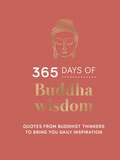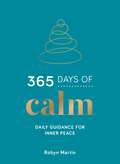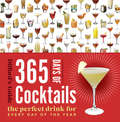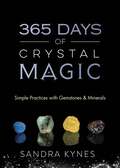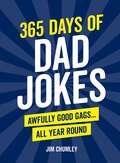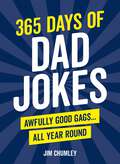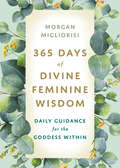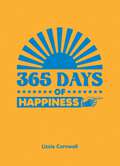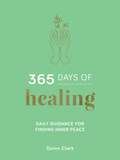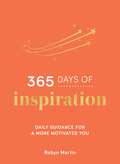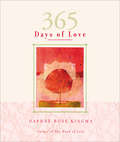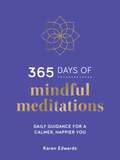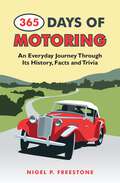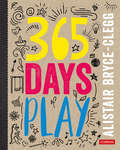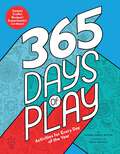- Table View
- List View
365 Days of Buddha Wisdom: Quotes from Buddhist Thinkers to Bring You Daily Inspiration
by Summersdale PublishersDiscover daily peace and wisdom with this pocket-sized collection of quotes from Buddhist teachers, writers and philosophers. Inside you will find 365 quotes from some of the greatest Buddhist thinkers of all time, including Thích Nhất Hạnh, Pema Chödrön, Alan Watts and, of course, the Buddha himself. Dive in and begin your own spiritual journey.
365 Days of Buddha Wisdom: Quotes from Buddhist Thinkers to Bring You Daily Inspiration
by Summersdale PublishersDiscover daily peace and wisdom with this pocket-sized collection of quotes from Buddhist teachers, writers and philosophers. Inside you will find 365 quotes from some of the greatest Buddhist thinkers of all time, including Thích Nhất Hạnh, Pema Chödrön, Alan Watts and, of course, the Buddha himself. Dive in and begin your own spiritual journey.
365 Days of Calm: Daily Guidance for Inner Peace
by Robyn MartinFind calm 365 days of the year with this little book of tips and quotes. It’ll transport you to a peaceful place, where you can focus on being present and reap the rewards of a more relaxed life. Staying calm is about how you deal with your emotions, and this little book is here to help you pinpoint what makes you stressed so you can stay in charge of your feelings. Within these pages are simple but effective tips on how to:Use breathing techniques and meditation to help you feel groundedPractise mindfulness to avoid catastrophizingImprove your health and well-being for a happier mindAs well as its many practical ideas, 365 Days of Calm includes a range of insightful quotes, from Lao Tzu to Cara Delevingne, to help restore the peace in your day.Learning how to create calm in your life will boost your well-being, mental health and inner strength, helping you to become a happier and healthier person.
365 Days of Calm: Daily Guidance for Inner Peace
by Robyn MartinFind calm 365 days of the year with this little book of tips and quotes. It’ll transport you to a peaceful place, where you can focus on being present and reap the rewards of a more relaxed life. Staying calm is about how you deal with your emotions, and this little book is here to help you pinpoint what makes you stressed so you can stay in charge of your feelings. Within these pages are simple but effective tips on how to:Use breathing techniques and meditation to help you feel groundedPractise mindfulness to avoid catastrophizingImprove your health and well-being for a happier mindAs well as its many practical ideas, 365 Days of Calm includes a range of insightful quotes, from Lao Tzu to Cara Delevingne, to help restore the peace in your day.Learning how to create calm in your life will boost your well-being, mental health and inner strength, helping you to become a happier and healthier person.
365 Days of Cocktails
by Difford'S GuideBe inspired 365 days a yearNo two days of the year will ever be the same again--with this book you can create a brand-new cocktail every day! We've traveled the globe and pulled together a compendium of quirky happenings, anniversaries, and even some traditional events to raise a glass to and toast. From our vast knowledge of the cocktail world we've paired each day with an appropriate cocktail. Celebrate Walt Whitman's birthday with a Grassy Finish, Groundhog Day with The Fog Cutter, and Star Wars Day with a Darth Jäger. You'll be more the merrier you did!Difford's Guide was established in 2001 and is now recognized as the world's cocktail expert. With an exhaustive cocktails website and the well-known Difford's Guide Cocktails Encyclopedia, consider it the last call for cocktail lovers everywhere.
365 Days of Colour In Your Garden
by Nick Bailey Note Bene LimitedA beautifully photographed guide for gardeners keen to attain the elusive colour-packed 'year-round garden'. Covering ideas on how to use, combine, design with and prolong colour, the book focuses on achievable ways of growing plants of every tone through 12 months of the year. It provides gardeners with an inspiring and surprising palette of plants to furnish their plots with sumptuous colour with detailed lists for Spring, Summer, Autumn and Winter. Bursting with practical advice on establishment and maintenance, the book also embraces plants for pots, cutting, difficult spaces and tiny gardens, and features long-season gardens from around the world.
365 Days of Crystal Magic: Simple Practices with Gemstones & Minerals
by Sandra KynesQuick and Easy Crystal Magic for Every DayDeepen your awareness, relieve your stress, and reach your goals with daily crystal magic. This fun, approachable book features simple and effective ways to use crystals throughout the wheel of the year. You can even incorporate them into your sabbat, full moon, historical, and special occasion celebrations.Perfect for any age or interest level, 365 Days of Crystal Magic provides indispensable knowledge on a variety of topics, including prepping and cleaning crystals, utilizing birthstones, and working magic according to the astrological bodies. Every calendar date features a practical idea for using crystals to find love and community, improve your divination, strengthen your willpower, lift your mood, and much more.
365 Days of Dad Jokes: Awfully Good Gags . . . All Year Round
by Jim ChumleyA Simon & Schuster eBook. Simon & Schuster has a great book for every reader.
365 Days of Dad Jokes: Awfully Good Gags... All Year Round
by Jim ChumleyPerfect for dads and lovers of cheesy puns and one-liners, this pocket-sized collection offers a year's worth of mirth suitable for all agesThere's something very special about dad jokes - they're always enjoyably terrible, sometimes quite witty and occasionally downright hilarious. So if you're a dad looking to add to your collection of funnies, or you'd like to beat your old man at his own game, this is the book for you.Packed into these pages are pithy wisecracks, comically cringeworthy puns, silly one-liners and enough other types of joke to last an entire year. Among the hundreds of groan-worthy gags you'll find gems like: How many tickles does it take to make an octopus laugh? Ten tickles. Why are balloons so expensive? Inflation. What do you call an elephant who doesn't matter? Irrelephant. How does the moon cut his hair? Eclipse it. Did you hear about the circus fire? It was in tents. Unapologetically themselves, just like dads, these are jokes to inflict with glee on all the family.
365 Days of Divine Feminine Wisdom: Daily Guidance for the Goddess Within
by Morgan MigliorisiA devotional-style book for the modern seeker, intended to help them remember the divine wisdom they carry within and utilize it to create a life that is authentic.Are you ready to activate your inner goddess?365 Days of Divine Feminine Wisdom is a devotional-style book for today's spiritual seeker. In it, you will learn how to deepen your connection with yourself and your spirituality, discover who you really are, and find the courage to create a life you love by using your innate gifts and power.Each daily entry reflects upon the different aspects of Divine Feminine energy that are always active within us, regardless of age or experience: the Maiden, the Mother, and the Crone. These aspects are linked to the milestones that we experience throughout our lives as we get in touch with the goddess within us. These aspects are also connected to the phases of the moon, as well as to the seasons.Each daily entry draws wisdom from the three-part feminine archetype, according to the time of year: January to April provides inspiration from the Maiden aspect; May to August offers guidance from the Mother aspect; and September to December reveals knowledge from the Crone aspect. This helps readers gain a full understanding of their innate gifts and wisdom, as well the phases they naturally go through each year as they continue to grow, evolve, and live their best life
365 Days of Happiness (365 Days Of... Ser.)
by Lizzie CornwallHost an air guitar tournament for your friends and family. Cartwheel down the street. Tell nothing but the truth all day. Prepare for a grand adventure, instigate a little mischief and embrace a sunnier outlook with this book of feel-good quotations and quirky ideas that will keep you smiling all year.
365 Days of Happiness (365 Days Of... Ser.)
by Lizzie CornwallHost an air guitar tournament for your friends and family. Cartwheel down the street. Tell nothing but the truth all day. Prepare for a grand adventure, instigate a little mischief and embrace a sunnier outlook with this book of feel-good quotations and quirky ideas that will keep you smiling all year.
365 Days of Healing: Daily Guidance for Finding Inner Peace
by Quinn ClarkWhen you are ready to take the first step to understand your past pain, the practical guidance in this book will support you on your healing journey, helping you to find your way back to yourself, come to terms with the past and look to the future with hope and positivity.
365 Days of Healing: Daily Guidance for Finding Inner Peace
by Quinn ClarkWhen you are ready to take the first step to understand your past pain, the practical guidance in this book will support you on your healing journey, helping you to find your way back to yourself, come to terms with the past and look to the future with hope and positivity.
365 Days of Inspiration: Daily Guidance for a More Motivated You
by Robyn MartinStimulate your mind 365 days of the year with this little book of tips and quotes. It’ll supercharge you with a new lease of life, helping you to get the most out of every day. Inspiration is everywhere, but it’s difficult to get creative sparks flying when you don’t know where to begin. This little book is here to help you try out new experiences, look at things with a fresh pair of eyes and feel passionate about the things you love. Within these pages are simple but effective tips on how to:Break from the ordinary and widen your perspectiveSay “yes” to new possibilitiesBe mindful of your surroundings and experiencesAs well as its many practical ideas, 365 Days of Inspiration includes a range of rousing quotes, from Oprah Winfrey to David Attenborough, to spark creativity.Discovering what motivates you will boost your well-being, mental health and inner strength, helping you to become more energized and positive every day of the year.
365 Days of Inspiration: Daily Guidance for a More Motivated You
by Robyn MartinStimulate your mind 365 days of the year with this little book of tips and quotes. It’ll supercharge you with a new lease of life, helping you to get the most out of every day. Inspiration is everywhere, but it’s difficult to get creative sparks flying when you don’t know where to begin. This little book is here to help you try out new experiences, look at things with a fresh pair of eyes and feel passionate about the things you love. Within these pages are simple but effective tips on how to:Break from the ordinary and widen your perspectiveSay “yes” to new possibilitiesBe mindful of your surroundings and experiencesAs well as its many practical ideas, 365 Days of Inspiration includes a range of rousing quotes, from Oprah Winfrey to David Attenborough, to spark creativity.Discovering what motivates you will boost your well-being, mental health and inner strength, helping you to become more energized and positive every day of the year.
365 Days of Kindness: Daily Guidance for Happiness and Gratitude
by Vicki VrintChoose kindness This little book will help you find time every day for small acts of kindness and love. With innovative tips and a collection of inspiring quotations, it will be your guide to spreading goodwill and gratitude all year round.
365 Days of Kindness: Daily Guidance for Happiness and Gratitude
by Vicki VrintChoose kindness This little book will help you find time every day for small acts of kindness and love. With innovative tips and a collection of inspiring quotations, it will be your guide to spreading goodwill and gratitude all year round.
365 Days of Love
by Daphne Rose KingmaIn 365 Days of Love, best-selling author Daphne Rose Kingma writes with startling insight and clarity on the meaning and magic of love, offering readers a welcome opportunity to reflect each day on the love in their lives. With her characteristic poetic prose and warmhearted style, Kingma explores the elements and expressions of love, helping the reader to see clearly its many-faceted possibilities. Designed to be read daily to inspire, affirm, remind, encourage, support, and comfort, this little book is the perfect companion for lovers of all ages. "Read it, one day at a time, to yourself or with someone you love, contemplate what it says, try to do what it asks of you, and your capacity to love (and be loved) will grow." -Daphne Rose Kingma
365 Days of Mindful Meditations: Daily Guidance for a Calmer, Happier You
by Karen EdwardsAll we have is now Find time for mindfulness every day with this calming little book. With a raft of inspiring quotations and simple ideas to help you savour each moment and find joy in little things, it will help you to live well all year round.
365 Days of Mindful Meditations: Daily Guidance for a Calmer, Happier You
by Karen EdwardsAll we have is now Find time for mindfulness every day with this calming little book. With a raft of inspiring quotations and simple ideas to help you savour each moment and find joy in little things, it will help you to live well all year round.
365 Days of Motoring: An Everyday Journey Through its History, Facts and Trivia
by Nigel FreestoneBelt up and enjoy this 365-day ride as you cruise past the most momentous motoring events in history. Packed with fascinating facts about races, motorists and the history of the mighty engine, this book is a must-have for any car enthusiast.
365 Days of Play (Corwin Ltd)
by Alistair Bryce-CleggThoughtfully curated by bestselling author and early years consultant Alistair Bryce-Clegg, this beautiful Pinterest-worthy book is brimming with 365 days worth of inspiration for early years practitioners. He draws on quotes, images, the thoughts of education and child development thinkers and the work of contemporary practitioners to create a picture of children's play today. Whether it's sitting down with your morning cup of coffee or as you wind down for the day, this beautifully designed full colour book is here to motivate and inspire you and your practice all year through.
365 Days of Play (Corwin Ltd)
by Alistair Bryce-CleggThoughtfully curated by bestselling author and early years consultant Alistair Bryce-Clegg, this beautiful Pinterest-worthy book is brimming with 365 days worth of inspiration for early years practitioners. He draws on quotes, images, the thoughts of education and child development thinkers and the work of contemporary practitioners to create a picture of children's play today. Whether it's sitting down with your morning cup of coffee or as you wind down for the day, this beautifully designed full colour book is here to motivate and inspire you and your practice all year through.
365 Days of Play: Activities for Every Day of the Year
by Megan Hewes ButlerWith an activity for every day, any day is a great day to explore, learn, and create something new!It's time to start your ULTIMATE year of games with 365 Days of Play! This go-to activity book for kids ages 4-8 includes an activity for every day of the year. An encyclopedia of play, it's everything you need to keep little minds and hands entertained--pages on pages of games, crafts, recipes, experiments, projects, jokes, songs, guides, skills, tricks, hacks, challenges, and everything else in the canon of kid. Follow the step-by-step instructions and illustrations to create a game wherever you are and with whatever you have--swing a pendulum, launch a parachute, shoot a confetti cannon, or throw a boomerang. Tie a square knot or untangle a human knot. Make an egg you can float, bounce, or keep forever. The hardcover book looks stunning on the shelf, toy chest, and coffee table, but will be well-loved by kids everywhere."This breezy compendium of simple ideas for solitary and group entertainment offers something for nearly everyone...an appealing reprieve from screens for families dealing with travel, rainy days, or simply needing to redirect attention...cheerfully designed and clearly presented...lots of great possibilities for fending off boredom." --Kirkus Reviews
